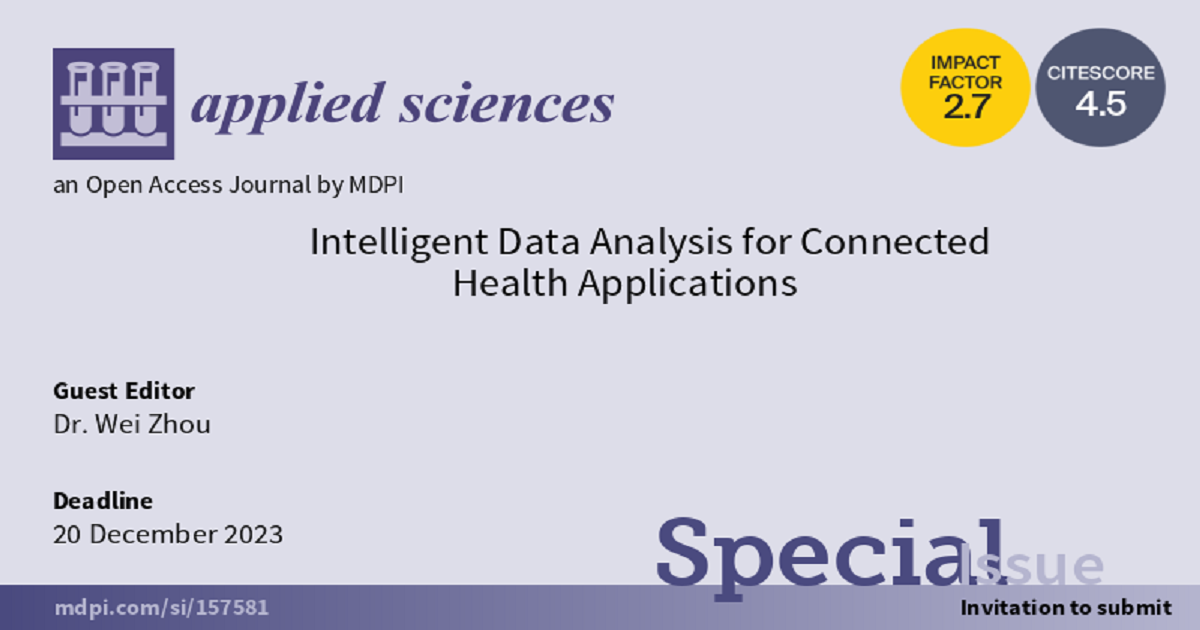Intelligent Data Analysis for Connected Health Applications
A special issue of Applied Sciences (ISSN 2076-3417). This special issue belongs to the section "Computing and Artificial Intelligence".
Deadline for manuscript submissions: closed (20 December 2023) | Viewed by 12911

Special Issue Editor
Interests: recommender systems; social networking; information retrieval; machine learning; data mining
Special Issues, Collections and Topics in MDPI journals
Special Issue Information
Dear Colleagues,
With the development of information technology, data from all walks of life are explosively generated. In this situation, the way to quickly and effectively mine valuable information and knowledge from the sea of data has become one of the important problems to be solved by all walks of life. Imbalanced data have become a research hotspot and direction for experts and scholars because they are very common in real life. Especially in the medical field, data imbalance is particularly prominent. It is highly feasible to mine effective information from medical data to assist doctors in decision making. This widespread data imbalance problem makes misclassification likely when dealing with the classification of imbalanced datasets. When the imbalance ratio is very high, it will cause a large classification loss. For the problem of class imbalance in medical data, the way to propose corresponding solutions from the data level and algorithm level, reduce the impact of data class imbalance on the model, and improve the prediction effect of the model are the topics that need to be studied.
Dr. Wei Zhou
Guest Editor
Manuscript Submission Information
Manuscripts should be submitted online at www.mdpi.com by registering and logging in to this website. Once you are registered, click here to go to the submission form. Manuscripts can be submitted until the deadline. All submissions that pass pre-check are peer-reviewed. Accepted papers will be published continuously in the journal (as soon as accepted) and will be listed together on the special issue website. Research articles, review articles as well as short communications are invited. For planned papers, a title and short abstract (about 250 words) can be sent to the Editorial Office for assessment.
Submitted manuscripts should not have been published previously, nor be under consideration for publication elsewhere (except conference proceedings papers). All manuscripts are thoroughly refereed through a single-blind peer-review process. A guide for authors and other relevant information for submission of manuscripts is available on the Instructions for Authors page. Applied Sciences is an international peer-reviewed open access semimonthly journal published by MDPI.
Please visit the Instructions for Authors page before submitting a manuscript. The Article Processing Charge (APC) for publication in this open access journal is 2400 CHF (Swiss Francs). Submitted papers should be well formatted and use good English. Authors may use MDPI's English editing service prior to publication or during author revisions.
Keywords
- imbalanced data mining
- feature recognition
- feature selection
- feature extraction
- medical image reconstruction
- medical image segmentation
- medical image classification
- medical image processing and recognition
- data mining
- machine learning
- deep learning
Benefits of Publishing in a Special Issue
- Ease of navigation: Grouping papers by topic helps scholars navigate broad scope journals more efficiently.
- Greater discoverability: Special Issues support the reach and impact of scientific research. Articles in Special Issues are more discoverable and cited more frequently.
- Expansion of research network: Special Issues facilitate connections among authors, fostering scientific collaborations.
- External promotion: Articles in Special Issues are often promoted through the journal's social media, increasing their visibility.
- Reprint: MDPI Books provides the opportunity to republish successful Special Issues in book format, both online and in print.
Further information on MDPI's Special Issue policies can be found here.





